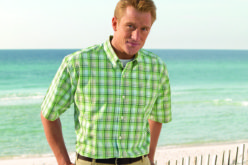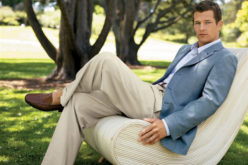Q. I’m 18 and moving to college next month and need some clothes that will be right. My grandparents gave me some money specifically to shop, but I have no real idea what is a more “mature, collegiate look.” Generally in high school I wore jeans (ripped and not), shorts, T-shirts. Can you provide a basic list starting from those, without going much over $500? Thanks.
A. I would say you are well on your way merely by understanding that now is the time for a more grown-up approach. You can’t imagine how many men – of all ages – insist that the world will just have to learn to accept them as they are and as they have always been. The unreality of such an approach is monumental. Yes, expressing your individuality is a plus, but there are always standards and rules to know first . . . before you break them. $500 is certainly a limitation for a whole wardrobe. If you don’t shop carefully, it would be easy to spend that much on one or two items, but you can get pretty far on that. And perhaps, when they see how far the money goes, they’ll provide a bit more for the big ticket items!
Building any wardrobe requires a plan to make it effective. The best college wardrobe is a balance of classic, adult clothes and fun wear. Begin with a core collection of certain basics:
- Striped button-down Oxford cloth shirt
- Blue dress shirt
- Navy blazer
- Khaki pants
- Well-cut blue jeans
- Gray pants
- Two short-sleeved knit polo shirts
- Traditional tie (stripe or small all-over pattern)
- Dark knit tie
- Short outerwear jacket
- Pullover sweater (crew neck, V-neck, or half-zip)
- T-shirts (in good condition)
- Sweat-suit (basic gray fleece or colorful variation)
- Pair of dark-colored deck shoes
- Raincoat (trench coat, slicker, or poncho)
When money is no object, you can be as cool and trendy as you please. But, when what you spend is a concern, then classic is best. These items are all on-going basics; they’re like best friends – dependable, reliable, and long-lasting. Buy them one or two at a time as you can afford them. Later on, add the fun extras. Here are a few approaches to cost-cutting shopping. Patronize high-quality stores, but shop during their “seasonal sales.” This may seem like an impossibility given your need to dress for this fall, but if you get input from a knowledgeable salesperson, you can start now and follow-up as the sales come. Lands’ End and L.L. Bean are mid-priced good choices that often have mark-down offers. Another strategy is to seek out reliable discount or outlet stores. There are also discounted items without tags or gently-used versions on sites such as eBay.
Speaking of gently used, thrift shops and vintage clothing stores can provide great finds (if you have “an eye” for tasteful styles that are still in good condition). Least expensive of all are items you discover in your Dad’s or your favorite uncle’s closet. Do some comparison shopping and be willing to try things on. All of these are good sources for your initial version of the pricier items – the blue blazer (if you don’t already have one from interviews/Sunday dress), trench coat, and a nice sweater).
With the limitations of purchasing pieces for each season, it is smart to make it habit of looking for comfortable fabrics (cottons and light-weight wools) that can be worn year-round. Also, choose clothes that interwork with items you already own. Try to focus on flattering colors for you; odds are this will make more of your pieces work well together.
In terms of where to start, I would try to track down that blazer, the khaki pants, a knit polo, and the striped button-down shirt.
Options and opportunities are endless with a handsome basic wardrobe.









